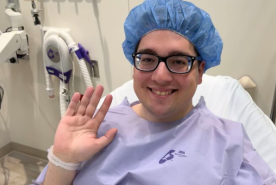August 01, 2023
Continuing education series for professionals.
At National Kidney Foundation, we believe that everyone who needs a kidney transplant should get one. As a kidney disease professional, you can help turn this goal into a reality. Here’s how to help your patients get on the kidney transplant waitlist, an overview of the transplant team, and strategies to help patients remain on the list. Together, we can expand access to life-saving kidney transplants.
When to refer a patient for a kidney transplant
The earlier the discussion about transplantation begins, the quicker patients can make lifestyle changes to be waitlisted.
"We prefer that patients are referred early, before dialysis if possible. We're not able to list them until their GFR hits 20 or below but the best care would have them evaluated beforehand, in the low 20s," said Dr. Goni Katz. "If we do this, they are able to get a transplant sooner."
The basic pre-transplant medical evaluation testing looks different for each patient and center. Some may require a telephone screening before seeing a patient, while others may invite them directly to the center. Here’s how to help patients get listed at multiple centers.
"The evaluation process is completed over a one to two-day period. During this time, patients see all members of the transplant team. It's our goal to educate them on what they need to do to get listed," said Dr. Katz. "We also run various tests to see if they are fit for transplantation. An echocardiogram and/or stress test determines whether they have enough cardiac reserves to undergo a transplant. A CAT scan of their abdomen and pelvis shows their vessel health. We check to see if they can handle the medications that suppress their immune system. We educate them on medication side effects and check for any sleeping or dormant cancer. Smokers or drinkers may need a liver function panel or CT of their chest."
Practitioners should also inform patients that they can be referred to and evaluated at different centers without repeating these tests. Once the patient is waitlisted, you'll want to continue checking them yearly or twice yearly to ensure they are still fit for transplant as time goes on.
"We recommend seeing the patient at least once during the evaluation and then on a yearly basis after being listed," said Dr. Ju Yung Kim. "If there is a frailty concern due to age or physical health, follow up at least once every six months to ensure they don't have any significant decline in their health status. We recommend frail patients go to physical therapy to work on their strength and mobility. I always tell my patients, the stronger you walk into the surgery, the more likely you'll be strong walking out of it and able to handle all of the medications."
Keep learning: KDOQI US Commentary on the 2020 KDIGO Clinical Practice Guideline on the Evaluation and Management of Candidates for Kidney Transplantation.
Transplant team member roles
There are many members of the transplant team, each having a vital role for the patient.
Transplant team members and roles include:
- Transplant physician: Does the physical evaluation, educates patients on the transplant procedure, and explains the risks and benefits of transplant.
- Coordinator: Facilitates the transplant process and acts as the patient's link to the transplant hospital.
- Transplant pharmacist: Assesses a patient's medication compliance and helps create a new medicine regime after transplant.
- Transplant social worker: Evaluate a patient's mental health, coping skills, and support system. They also review their transportation and financial ability to have a transplant.
- Transplant dietitian: Evaluates a patient's nutritional and functional status, as well as their frailty. Provides education on maintaining or improving health while waiting for a transplant and after.
- Financial counselor: Educates patients on current insurance coverage and costs they may have after the transplant.
Learn more about the transplant care team.
Helping patients remain on the transplant waitlist
Staying healthy on the waitlist is similar to the practices patients use to get listed.
"The patient needs to continue a healthy diet and lifestyle to prevent themselves from becoming frail, deconditioned, or malnourished," Heather Lordon, kidney dietitian, said. "Unfortunately, a lot of patients, whether they're on dialysis or not, tend to make a lot of changes to get listed and then relax or revert to their old habits. It’s most important to remain healthy on the waitlist because you never know when they’ll get the call about an available kidney.”
Encourage waitlisted patients to:
- Eat healthily
- Watch potassium and phosphorus levels
- Get the right amount of protein
- Exercise
- Maintain blood sugars
Following these instructions may be difficult for patients, but your guidance and encouragement can make all the difference.
Take the test to earn your CE credit.
Resources to share with your patients
These resources may help your patients get and stay on the kidney transplant waitlist:
- First Steps to Transplant Course
- Finding a Living Donor Course
- Big Ask Big Give Events
- How to Share Your Story and Find a Living Kidney Donor
- NKF Peers, a mentoring program for kidney patients
Earn CE On the Go
Listen and earn CE as our panelists delve into the subjects that matter most to you while offering in-depth clinical updates and real-world examples of these changes. Subscribe to The Kidney Commute Podcast.


















